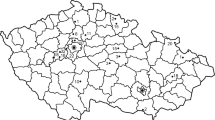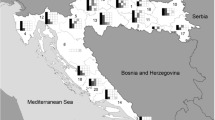Abstract
The virus status of New Zealand honey bee colonies infested with Varroa destructor was studied from 2001 to 2003. The viruses CBPV, BQCV, SBV, CWV, and KBV were all found during the study, with CWV and KBV the most common, as inferred from serological and protein profile analyses. DWV, SPV and ABPV were not detected in these colonies. CWV was present in the colonies throughout the season, while the appearance of KBV generally coincided with autumn colony collapse when V. destructor populations were large. Inconsistencies between serological analyses and viral capsid protein profiles of the extracts containing CWV and KBV were probably a result of strain differences between the viruses found in New Zealand and those used to generate the diagnostic antisera. The genome of the New Zealand KBV strain was partially sequenced. Phylogenetic and serological analyses showed this strain to be unique and most closely related to Canadian KBV isolates.
Zusammenfassung
Beim Saugen an adulten Bienen und an Puppen kann die parasitische Milbe Varrao destructor verschiedene Honigbienenviren über Bienenpopulationen hinweg verbreiten. Diese Viren verursachen Infektionen, die zum Tod oder zu Missbildungen bei der infizierten Brut und adulten Bienen führen können, und damit letztendlich zum Absterben der betroffenen Bienenvölker. Vier Bienenvieren konnten bereits mit Völkerverlusten in Europa und den USA in Zusammenhang gebracht werden: das Kaschmir-Bienenvirus (KBV), das Akute-Bienenparalysevirus (ABPV, das Langsame-Paralysevirus (SBV) und das Verkrüppelte-Flügelvirus (DWV). Wir benutzten eine Reihe von Methoden, um nachzuweisen, welche dieser Viren in Milben und absterbenden Völkern in Neuseeland vorkommen. Von 30 im November 2001 etablierten Völker waren im Mai 2002 alle tot, und weitere 13 im November 2002 etablierte Völker starben im August 2003. Bereits erste serologische Untersuchungen wiesen vermehrt auf einen Befall mit dem Trübe-Flügelvirus (CWV) hin (Abb. 1a und 1b). Aber dieses war nicht in allen Fällen mit dem Zusammenbruch jener Völker assoziiert. Mittels einer SDS-PAGE-Analyse von Bienenextrakten konnten wir ein Muster viraler Capsidproteine nachweisen, die dem bekannter KBV-Stämme ähnlich war (Abb. 2a). Dieses Profil stimmte auch mit dem von Bienen überein, die als Folge einer Injektion mit Kopfextrakten lebender Bienen gestorben waren (Abb. 2b). AGID (Agar-Gel-Immunodiffusion) Tests mit steigenden Konzentrationen von Antiseren gegen verschiedene KBV-Stämme ergab positive Reaktionen, was darauf hinwies, dass das Virus ein neuseeländischer KBV-Stamm (KBV-NZ) sein könnte. Das Virus etablierte sich in der Bienenpopulation im späten Sommer und Herbst, als die Milbenpopulation in diesen Völkern hoch war (Abb. 1b). Eine RT-PCR (reverse-Transkriptions-Kettenpolymerasereaktion) Analyse mit Milben aus zusammenbrechenden Völkern (mithilfe der in Tab. I aufgelisteten Primer) detektierte eindeutig ein KBV-Produkt und wies daraufhin, dass die Milben das Virus verbreiteten. Das Genom dieses KBV-NZ Stamms wurde kloniert und partiell sequenziert (Abb. 3) und eine phylogenetische Analyse zeigte, dass es eng verwandt ist mit KBV-Isolaten aus Kanada und den USA (Abb. 4). Eine Direktsequenzierung der RT-PCR-Produkte der Virusextrakte aus 2002–2003 resultierte in zwei eng verwandten Sequenzvarianten (A und B; Abb. 4) des KBV-NZ Stamms. Unterschiede in der Aminosäurensequenz der Strukturproteine zwischen dem KBV-NZ und dem KBV-Pennsylvanien Stamm (Abb. 5) könnten der Grund sein für das unterschiedliche serologische Verhalten dieser Virusisolate. Die Ergebnisse zeigen, dass KBV-Infektionen eine wichtige Rolle spielen und grosse Schäden in Varroa destructor befallenen neuseeländischen Bienenvölkern verursachen. Der Virulenzgrad dieser Infektion deutet an, dass eine hohe Milbenpopulation erforderlich ist, um eine Infektion in dem entprechenden Volk aufrechtzuerhalten. Eine Kontrolle der Milbenpopulation sollte dementprechend ein aussichtsreiches Verfahren sein, um den Ausbruch epidemischer KBV-Infektionen zu verhindern. Weitere Untersuchungen werden notwendig sein, um diese Hypothese zu testen. Interessanterweise fanden wir selbst mittels sensitiver RT-PCR-Methoden kein Verkrüppelte-Flügelvirus in Bienen- und Milbenproben aus Neuseeland.
Similar content being viewed by others
References
Allen M.F., Ball B.V. (1995) Characterisation and serological relationships of strains of Kashmir bee virus, Ann. Appl. Biol. 126, 471–484.
Allen M., Ball B. (1996) The incidence and world distribution of honey bee viruses, Bee World 77, 141–162.
Allen M.F., Ball B.V., White R.F., Antoniw J.F. (1986) The detection of acute paralysis virus in Varroa jacobsoni by the use of a simple indirect ELISA, J. Apic. Res. 25, 100–105.
Anderson D.L. (1985) Viruses of New Zealand honey bees, N. Z. Beekeep. 188, 8–10.
Anderson D.L. (1988) Pathologist’s report, N. Z. Beekeep. 199, 12–15.
Anderson D.L. (1991) Kashmir bee virus — a relatively harmless virus of honey bee colonies, Am. Bee J. 131, 767–770.
Anderson D.L., Gibbs A.J. (1988) Inapparent virus infections and their interactions in pupae of the honey bee (Apis mellifera Linnaeus) in Australia, J. Gen. Virol. 69, 1617–1625.
Anderson D.L., Gibbs A.J. (1989) Transpuparial transmission of Kashmir bee virus and sacbrood virus in the honey bee (Apis mellifera), Ann. Appl. Biol. 114, 1–7.
Bailey L. (1965) Paralysis of the honey bee, Apis mellifera Linnaeus, J. Invertebr. Pathol. 7, 132–140.
Bailey L., Woods R.D. (1977) Two more small RNA viruses from honey bees and further observations on sacbrood and acute bee-paralysis viruses, J. Gen. Virol. 37, 175–182.
Bailey L., Ball B.V. (1991) Honey bee pathology, Academic Press Limited, London.
Bailey L., Carpenter J.M., Woods R.D. (1979) Egypt bee virus and Australian isolates of Kashmir bee virus, J. Gen. Virol. 43, 641–647.
Bakonyi T., Farkas R., Szendröi A., Dobos-Kovács M., Rusvai M. (2002) Detection of acute bee paralysis virus by RT-PCR in honey bee and Varroa destructor field samples: rapid screening of representative Hungarian apiaries, Apidologie 33, 63–74.
Ball B.V. (1997) Varroa and Viruses, in: Munn P., Jones R. (Eds.), Varroa! Fight the Mite, International Bee Research Association, Cardiff, Wales, pp. 11–15.
Ball B.V., Allen M.F. (1988) The prevalence of pathogens in honey bee (Apis mellifera) colonies infested with the parasitic mite Varroa jacobsoni, Ann. Appl. Biol. 113, 237–244.
Bowen-Walker P.L., Martin S.J., Gunn A. (1999) The transmission of deformed wing virus between honeybees (Apis mellifera L.) by the ectoparasitic mite Varroa jacobsoni Oud, J. Invertebr. Pathol. 73, 101–106.
Brødsgaard C.J., Ritter W., Hansen H., Brødsgaard H.F. (2000) Interactions among Varroa jacobsoni mites, acute paralysis virus, and Paenibacillus larvae larvae and their influence on mortality of larval honeybees in vitro, Apidologie 31, 543–554.
Calderón R.A., van Veen J., Arce H.G., Esquivel M.E. (2003) Presence of deformed wing virus and Kashmir bee virus in Africanized honey bee colonies in Costa Rica infested with Varroa destructor, Bee World 84, 112–116.
Chen Y.P., Pettis J.S., Evans J.D., Kramer M., Feldlaufer M.F. (2004) Transmission of Kashmir bee virus by the ectoparasitic mite Varroa destructor, Apidologie 35, 441–448.
Chen Y.P., Higgins J.A., Feldlaufer M.F. (2005) Quantitative real-time reverse transcription-PCR analysis of deformed wing virus infection in the honeybee (Apis mellifera L.), Appl. Environ. Microbiol. 71, 436–441.
Dall D.J. (1985) Inapparent infection of honey bee pupae by Kashmir and sacbrood bee viruses in Australia, Ann. Appl. Biol. 106, 461–468.
DeGrandi-Hoffman G., Curry R. (2004) A mathematical model of varroa mite (Varroa destructor Anderson and Trueman) and honeybee (Apis mellifera L.) population dynamics, Int. J. Acarol. 30, 259–274.
de Miranda J.R., Drebot M., Tyler S., Shen M., Cameron C.E., Stoltz D.B., Camazine S.M. (2004) Complete nucleotide sequence of Kashmir bee virus and comparison with acute bee paralysis virus, J. Gen. Virol. 85, 2263–2270.
Ellis J.D., Munn P.A. (2005) The worldwide health status of honey bees, Bee World 86, 88–101.
Evans J.D. (2001) Genetic evidence for co-infection of honeybees by acute bee paralysis and Kashmir bee viruses, J. Invertebr. Pathol. 78, 189–193.
Goodwin M. (2004a) Will there be a shortage of beehives for pollination? Kiwifruit: N. Z. Kiwifruit J. 166, 14–15.
Goodwin M. (2004b) Introduction and spread of varroa in New Zealand, Bee World 85, 26–28.
Goodwin M., Van Eaton C. (2001) Control of varroa: A guide for New Zealand beekeepers, New Zealand Ministry of Agriculture and Forestry, Wellington.
Govan V.A., Leat N., Allsopp M., Davison S. (2000) Analysis of the complete genome sequence of acute bee paralysis virus shows that it belongs to the novel group of insect-infecting RNA viruses, Virology 277, 457–463.
Harlow E., Lane D.P. (1988) Antibodies: A laboratory manual, Cold Spring Harbor Laboratory Press, New York.
Hung A.C.F. (2000) PCR detection of Kashmir bee virus in honey bee excreta, J. Apic. Res. 39, 103–106.
Hung A.C.F., Ball B.V, Adams J.R., Shimanuki H., Knox D.A. (1996) A scientific note on the detection of American strains of acute paralysis virus and Kashmir bee virus in dead bees in one US honey bee (Apis mellifera L) colony, Apidologie 27, 55–56.
Lanzi G., de Miranda J.R., Boniotti M.B., Cameron C.E., Lavazza A., Capucci L., Camazine S.M., Rossi C. (2006) Molecular and biological characterization of deformed wing virus of honeybees (Apis mellifera L.), J. Virol. 80, 4998–5009.
Martin S.J. (2001) The role of Varroa and viral pathogens in the collapse of honeybee colonies: a modelling approach, J. Appl. Ecol. 38, 1082–1093.
Martin S., Hogarth A., van Breda J., Perrett J. (1998) A scientific note on Varroa jacobsoni Oudemans and the collapse of Apis mellifera L. colonies in the United Kingdom, Apidologie 29, 369–370.
Nordström S. (2003) Distribution of deformed wing virus within honey bee (Apis mellifera) brood cells infested with the ectoparasitic mite Varroa destructor, Exp. Appl. Acarol. 29, 293–302.
Nordström S., Fries I., Aarhus A., Hansen H., Korpela S. (1999) Virus infections in Nordic honey bee colonies with no, low or severe Varroa jacobsoni infestations, Apidologie 30, 475–484.
Shen M., Cui L., Ostiguy N., Cox-Foster D. (2005) Intricate transmission routes and interactions between picorna-like viruses (Kashmir bee virus and sacbrood virus) with the honeybee host and the parasitic varroa mite, J. Gen. Virol. 86, 2281–2289.
Siede R., Büchler R. (2004) Erstbefund des Kaschmir-Bienen-Virus in Hesse, Berl. Münch. Tierärztl. Wschr. 117, 12–15.
Siede R., Derakhshifar I., Otten C., Berényi O., Bakonyi T., Köglberger H., Büchler R. (2005) Prevalence of Kashmir bee virus in central Europe, J. Apic. Res. 44, 129.
Stoltz D., Shen X.-R., Boggis C., Sisson G. (1995) Molecular diagnosis of Kashmir bee virus infection, J. Apic. Res. 34, 153–160.
Sumpter D.J.T., Martin S.J. (2004) The dynamics of virus epidemics in Varroa-infested honey bee colonies, J. Anim. Ecol. 73, 51–63.
Swofford D.L. (1998) PAUP* Phylogenetic Analysis Using Parsimony (* and other methods), version 4.0, Sinnauer Associates, Sunderland, Massachusetts.
Tentcheva D., Gauthier L., Jouve S., Canabady-Rochelle L., Dainat B., Cousserans F., Colin M.E., Ball B.V., Bergoin M. (2004a) Polymerase Chain Reaction detection of deformed wing virus (DWV) in Apis mellifera and Varroa destructor, Apidologie 35, 431–439.
Tentcheva D., Gauthier L., Zappulla N., Dainat B., Cousserans F., Colin M.E., Bergoin M. (2004b) Prevalence and seasonal variations of six bee viruses in Apis mellifera L. and Varroa destructor mite populations in France, Appl. Environ. Microbiol. 70, 7185–7191.
Thompson J.D., Higgins D.G., Gibson T.J. (1994) CLUSTAL W: improving the sensitivity of progressive multiple sequence alignment through sequence weighting, position-specific gap penalties and weight matrix choice, Nucleic Acids Res. 22, 4673–4680. [online] http://www.ebi.ac.uk/clustalw/ (accessed on 18 June 2005).
Valles S.M., Strong C.A., Dang P.M., Hunter W.B., Pereira R.M., Oi D.H., Shapiro A.M., Williams D.F. (2004) A picorna-like virus from the red imported fire ant, Solenopsis invicta: initial discovery, genome sequence, and characterization, Virology 328, 151–157.
Yue C., Genersch E. (2005) RT-PCR analysis of deformed wing virus in honeybees (Apis mellifera L.) and mites (Varroa destructor), J. Gen. Virol. 86, 3419–3424.
Zhang Z.Q. (2000) Notes on Varroa destructor (Acari: Varroidae) parasitic on honeybees in New Zealand, Syst. Appl. Acarol. Spec. Publ. 5, 9–14.
Author information
Authors and Affiliations
Corresponding author
Rights and permissions
About this article
Cite this article
Todd, J.H., De Miranda, J.R. & Ball, B.V. Incidence and molecular characterization of viruses found in dying New Zealand honey bee (Apis mellifera) colonies infested with Varroa destructor . Apidologie 38, 354–367 (2007). https://doi.org/10.1051/apido:2007021
Received:
Revised:
Accepted:
Issue Date:
DOI: https://doi.org/10.1051/apido:2007021




